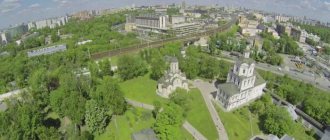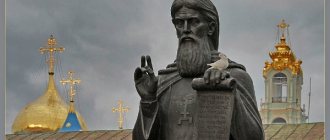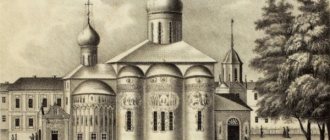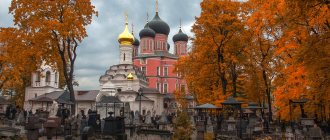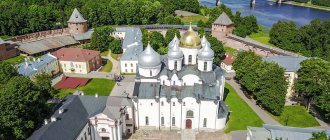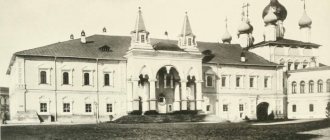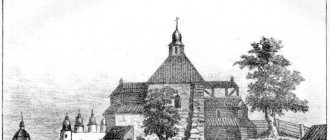The Kiev Pechersk Lavra is an ancient and one of the main shrines of Orthodox believers, a unique complex that has no analogues in the whole world. Here you can see temples from the 11th century preserved almost in their original form. This is the first monastery of Kievan Rus. Now every year thousands of pilgrims from all over the country and neighboring countries come here to look at the relics of the saints.
Short story
The Lavra is located in the southern part of Kyiv on the right bank of the Dnieper. The temple complex occupies two hills, which are separated from each other by a deep hollow that goes down to the river.
In the 11th century, it was here that the priest Hilarion went to pray. He dug a cave for himself. In 1051 Hilarion was elected metropolitan, so he left the cave. At the same time, monk Anthony from Athos (founder) arrived in the city. He did not like living in the monasteries of Kyiv, so he moved to Hilarion's cave.
Soon the monk had followers, among whom was Theodosius. When their number reached 12, they built a small church and cells. Anthony decided to move near this place and began working on a new cave in a nearby mountain.
Gradually the number of monks grew, and the caves became crowded. They built the Church of the Assumption of the Blessed Virgin Mary, after which the number of people coming only increased. Hegumen Anthony asked Prince Izyaslav to occupy the entire mountain above the cave. In 1062 the Pechersky Monastery was built.
The monks were able to attract a huge number of donations. Already in 1073, construction of a stone church began.
The foundation of the Kiev-Pechersk Monastery occurred in 1051, but this complex still exists today . Nowadays the laurel is usually divided into:
- Upper;
- Bottom.
There is still a monastery in Nizhnyaya, and there are caves of the Kiev Pechersk Lavra, which are divided into Near and Far. Some sources claim that it is an extensive cave system that even connects to temples in neighboring cities.
St. Andrew's Cathedral
St. Andrew's Cathedral
One of the most beautiful and mystical churches in Kyiv. Located above Podil, St. Andrew's Church majestically towers over the entire city. Unfortunately, in recent years it has been impossible to get into the Church; reconstruction work is underway.
Read: Where the soul feels better: the monasteries of Kyiv
Raids and restoration of the monastery
The monastery was raided several times, but it was always rebuilt. The temple complex moved:
- destruction in 1096;
- ruin in 1240;
- arson in 1483.
In 1096, the Polovtsians caused great damage to the monastery, but the monastery was quickly rebuilt. Gradually new churches were built. Theodosius created a shelter for the lame, the poor and the blind, on whom 10% of the income was spent. After the resettlement of the brethren, a tomb for the monks was made from the caves.
In 1240, the Pechersk Lavra was severely devastated during the Mongol invasion. Batu managed to get to her. Many novices were killed, only a small part of them managed to escape. In the 14th century, the temple was reopened , and in 1470 it was restored and decorated.
The last time the monastery was terrorized was in 1483. It was burned and robbed by the Crimean army, but thanks to large donations the monastery quickly recovered. At that time, the monastery already owned about 65 villages and 2 cities - Vasilkov and Radomysl.
Church of the Assumption of the Virgin Mary Pirogoschi
Church of the Assumption of the Virgin Mary Pirogishchi
The unique Temple, which survived 3 fires and all sorts of destruction, was built in the style of classicism. Today the Temple is the main decoration of Podol. It was erected back in the 12th century by the princes of Kyiv. And the pearl of Orthodoxy received its name thanks to the icon of the Mother of God, which was popularly called “Pirogische”.
Monastery objects
When visiting the Lavra, it is advisable to purchase a map of the complex and a schedule of excursions and services. This is due to the fact that there are a huge number of different structures on the territory. In addition to the Assumption Cathedral, there is:
- Onufrievskaya Tower.
- Church of the Nativity of the Blessed Virgin Mary.
- Refectory Church.
- Bell towers on caves.
- Trinity Gate Church.
- Church of the Exaltation of the Cross.
- Temple of the Icon of the Mother of God.
- Church of the Savior on Berestov.
- Annozachatievskaya Church.
- Church of All Saints.
- "Life-giving spring"
- Hospital chambers of the Nikolsky Monastery.
- Galleries.
- Cells.
There is also a Lavra store where you can buy candles, prayer books, souvenir photos, etc. There you can find out the latest news about the monastery, descriptions of excursions, a route map (address) to a specific building where the service will take place.
The nearby caves are also called Antoniev caves; the relics of saints rest here. The main and first abbot Anthony is buried in the Kiev Pechersk Lavra. It was he who founded the monastery.
There are three streets, an underground church and a refectory where the monks ate their meals. Inside are the relics of 79 saints, including:
- Alipiya Pechersky;
- Ilya Muromets;
- Nestor the Chronicler.
The relics of 49 saints are kept in distant caves. There is an underground church where Theodosius is buried.
The Upper and Lower Caves are a place of pilgrimage. Thousands of people come to Ukraine every year from other countries to visit the Lavra. This is one of the most important places in Orthodoxy.
Trinity Gate Church
The cross-domed church was erected in 1108 with the money of Prince Svyatoslav Davydovich, who had great honor among the townspeople in Kyiv. After this, he decided to take monastic vows and become a Venerable Saint. The building still has the design it had in the 12th century.
The main building materials for this temple, as for other structures of the monastery, were stone and square brick.
In its design and appearance, the monastery is similar to the Annunciation Church, towering above the city. At first, a dome was made in the shape of a hemisphere, but at the beginning of the 18th century it was replaced with a pear-shaped one.
On the north side, a stone extension was made instead of a wooden bell tower. During this period, the temple acquired new shapes that were characteristic of the Ukrainian Baroque.
The appearance of the church changed frequently. In the first half of the 18th century, students of the painting school decorated the facade of the building with murals on biblical themes. The gilded iconostasis was also made by masters of the Lavra.
Elders' cells
After entering the main gate, the guest of the monastery finds himself in an alley, where on both sides there are cells in which the cathedral elders lived. On the left is building No. 4, the length of which is 140 meters. On the right is building No. 3, 64 meters long. Both of these structures have a high pitched roof. The end sides are closed with beautiful and very interesting pediments, equipped with stucco ornaments and other decorations.
The walls are divided by pilasters and profiled cornices, decorated with sandriks. The approximate date of construction of the structures is the 20s of the 18th century. The buildings fully reflect the trends in Russian architecture of those years. Each of the buildings is divided into cells, which served as a dwelling for one elder.
During the Great Patriotic War, the buildings were practically destroyed. It was possible to restore the cells only in 1963. These premises now house exhibitions. There is also a souvenir shop called “Souvenirs” on site.
Assumption Cathedral
This building is considered a real pearl of ancient architecture. During the Great Patriotic War, the Assumption Cathedral, unfortunately, was completely destroyed. Now you can only look at the remaining ruins, which are located in the central square.
Another interesting fact is that the cathedral was the first building of the complex made of stone, and occupied the main place in this diverse architectural ensemble. Construction lasted from 1073 to 1077. At that time the cathedral was a single-tower structure 43 meters high. In 1089, work on painting the walls was completed. In addition to Greek masters, the painter Alipius took part in decorating the interior. He studied mosaic making in Greece. At the beginning of the 12th century, the Church of St. John the Baptist was added to the main building.
Unusual architectural solutions began to be adopted for the construction of temples and various structures in other cities of Kievan Rus. During the history of its existence, the Assumption Cathedral was destroyed many times, but always rose from the ruins.
After a big fire in 1718, the temple was greatly enlarged. He acquired seven domes. Inside and outside it was decorated in the Baroque style, which gave it elegance and solemnity. The interior painting was done by P. Popovich and his group. Various compositions on themes from the Bible were painted on the surface of the walls. At the end of the 19th century, this painting was replaced with a new one.
The wooden five-tiered iconostasis was a real work of art. At that time its height was 22 meters. About 300 famous historical figures are buried in the Assumption Cathedral. Among them are P. Mogila, P. Berinda, I. Gizel, K. Ostrogsky, P. Rumyantsev-Zadunaysky. Several generations of Dolgorukys were also buried here.
Sofia Kyiv
Sofia Kyiv
Another gem with a huge history. The temple grounds are beautiful and landscaped. Here it will be interesting to climb the high Bell Tower, climbing the steps of which you will feel like the heroes of the film “Notre Dame de Paris”. You can also visit the main churches of St. Sophia of Kyiv and see how the monks lived here.
Nicholas Church
Nicholas Church
This church is one of the most beautiful Christian buildings in Kyiv. Looking at St. Nicholas Church, you get the impression that you are in Paris or Barcelona, it is so beautiful and majestic. Since 1980, the House of Organ and Chamber Music has existed in the Temple. And it was built at the end of the 19th century in the neo-Gothic style.
Read: Study, student: top 7 popular universities in Kyiv
Devotees of the Kiev Pechersk Lavra
The Cathedral of the Saints of Pechersk includes about 160 ascetics. At the time of the revolution of 1917, in the caves of the Lavra there were 121 tombs with the relics of saints (including the relics of St. Metropolitan Michael, which were in the temple). It is interesting that the caves contain the relics of not only the ascetics who lived in the Lavra. In the 20th century, after the revolution, a large number of ascetics were canonized as Saints: Vladimir of Epiphany, Pavel of Tobolsk, Peter Mogila, Paisius, Theophilus, Jonah of Kyiv, Kuksha of Odessa.
Content
- 1History 1.1Foundation
- 1.2Raids and restoration of the monastery
- 1.3Attempts at reassignment
- 1.4XVII - XIX centuries
- 1.5Soviet era
- 1.6 Revival of the monastery; modern life
Church of St. Nicholas the Wonderworker on the Waters
Church of St. Nicholas the Wonderworker on the Waters
One of the most beautiful churches in Kyiv. Parishioners from all Ukrainian cities come here. This is the only Church in Ukraine located on the water, which can be reached via a bridge. For Kiev residents and guests of Kyiv, the Church of St. Nicholas the Wonderworker on the Waters has become the “calling card” of the city.
Ancient Kiev-Pechersk "Paterik"
The Kiev-Pechersk “Paterik” is one of the most ancient in Rus'.
The Patericon mentions ascetics of the 11th – 13th centuries. The book about the Kiev Pechersk Lavra was published in the 15th century. The Kiev-Pechersk Patericon contains works about the Kiev-Pechersk Lavra by various authors. There you can see excerpts from the ancient chronicles of Nestor the Chronicler, who wrote “The Life of St. Theodosius of Pechersk,” as well as records of Bishop Simon of Suzdal and monk Polycarp. Read: Famous Kyivians: photographer Semyon Fridlyand
Church of St. Nicholas the Good
Church of St. Nicholas the Good
The Temple of St. Nicholas the Good is another Kiev shrine, described in the books of the famous Ukrainian writer, Lada Luzina. The Church was built in the 19th century according to Melensky's design. During the Soviet years, the temple was destroyed. Today only the bell tower remains. In this temple in 1913, Bulgakov’s wedding to his first wife took place.
Church of St. Theodosius of Chernigov UOC
Church of St. Theodosius of Chernigov UOC
IDPs from Pripyat and Chernobyl came to this temple after the Chernobyl disaster. The temple received its name in honor of St. Theodosius (patron of the liquidators of the Chernobyl Nuclear Power Plant). In the 2010s, the walls of the temple were finally painted.
Read: They are no more: ten lost architectural monuments of Kyiv
Temple of St. Roman the Sweet Singer
Temple of St. Roman the Sweet Singer
The temple was erected at the end of the 19th century. During the Soviet years it was not destroyed, but was used as an administrative building. In the 2000s, the barn and chapel at the Temple of St. Roman the Sweet Singer were reconstructed. Today everyone can visit this temple. There is also a library and Sunday school on its territory.
